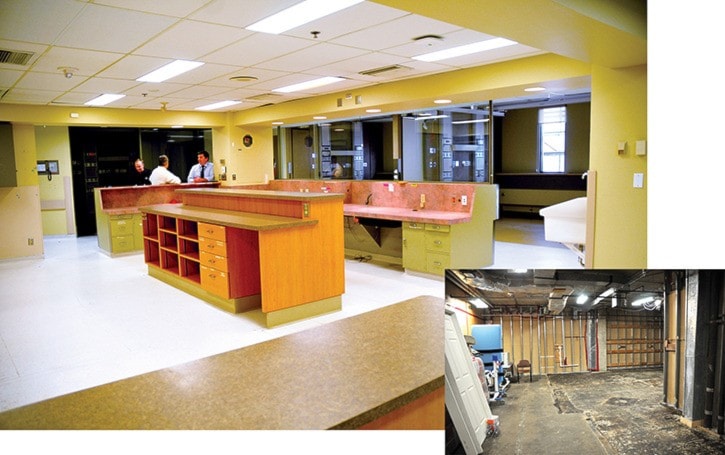Health care disciplines in sync with hospital procedure made for a smooth transition of patients from second floor to fourth at Kootenay Boundary Regional Hospital (KBRH) this week.
The move is temporary, but will last for the duration of patient-centric renovations in the region’s only Intensive Care Unit (ICU), in situ since the ’70s
Major upgrades ring in at $1.77 million, and involve three high level infrastructure projects, expected to be completed by mid-October.
Wall repair and window replacement may sound rather ordinary, but in fact, increasing natural light via larger glass panes, is a key component to improving patient care.
“Natural light in meeting circadian rhythms, decreases delirium and length of stay,” explains Sarah McLeod, referring to physical, mental and behavioral changes that follow a 24-hour cycle. “We used to sedate patients heavily and they would be on ventilators for extended periods of time,”added McLeod, KBRH manager for critical care and HART (high acuity response team). “Now we have better measures, different medications, and much more sophisticated ventilators.”
Sedation is minimized so weaning from ventilators is much quicker - meaning, patients are wakened much sooner and exposure to natural light helps orientate them to time, place and person.
Another key project focuses on improved infection control. Bedside curtains in the six-bed ICU will be replaced by glass doors, aging fixtures will be upgraded, and a new T-bar ceiling is in the works.
Project Manager Jonathan Jinjoe walked the Trail Times through the empty ward this week, pointing out extensive re-design plans which completely shift the model of care by de-centralizing the nursing station and re-configuring the unit into patient-centric “pods.”
“The whole process of moving was a huge plan that took place between plant services and clinical staff,” he began, noting the original plan was to complete each project in stages, which meant moving patients during each phase. “It was our clinical lead for the site, Jane Cusden (KBRH acute health services director), who made the decision once we had funding in place, that relocating the ICU was the way to go so we could do the renovations properly.”
Jinjoe said all six rooms will be demolished and re-built in a modern ICU design that allows nurses to work outside each room, or “pod,” instead of at a main nursing station.
“Basically, that means most of the nursing will be done at the bedside,” he added.
The bathroom will be re-configured, equipment storage will replace the current nursing base, and square-footage will increase when crews construct an airborne isolation room in the adjacent space, which was formerly the renal unit.
“We are a six bed ICU but we will end up with seven physical beds including the airborne isolation room,” clarified McLeod.
The isolation room will have the capacity for an ICU patient, but will also benefit less critical patients with suspected (and confirmed) airborne pathogens.
“For example, if there is a medical patient in Nelson, who is suspected to have TB, they would be able to come to us,”she explained. “That patient may not necessarily need ICU care, but the room is a resource.
“We would be able to put them in isolation and care for them, where we are able to keep the staff safe and the patient safe.”
McLeod has been in the nursing profession for 30 years, 18 of those at KBRH.
She’s seen much change in the field but says one thing remains constant - the ICU patients are still as sick.
But care is constantly improving as education advances, skills are kept up-to-the-minute and modern critical care equipment replaces the outdated models.
“Our patient care standards are very driven by research and aligned with the Kelowna network and with the province,” she said. “So we know we are providing really good care.
“We have a really engaged staff and a really great staff,”added McLeod. “We do the nursing, the physicians, our team of pharmacists, physios, respiratory therapists - everybody works together and we have a great team. I think this infrastructure (renovation) values and reflects the work we do.
“And it’s a real positive when your work environment is improved - it’s a great thing, it really is.”
The Ministry of Health is contributing almost $1.3 million through Interior Health for the renovation, including $500,000 for the glass doors, walls and fixture replacement.
The West Kootenay Boundary Regional Hospital District has directed $485,200 toward wall and window replacement, including $190,000 for the isolation room. The KBRH Foundation is currently fundraising the remaining $57,000.
“My feeling, as a non-clinician, is that it’s the staff that provide the care, not the building,” Jinjoe said. “The building helps, but it’s the staff. And the staff hasn’t changed, they just went to a temporary location like going to a summer cottage - it may be a bit more crowded but the level of care and quality of care remains unchanged.”
